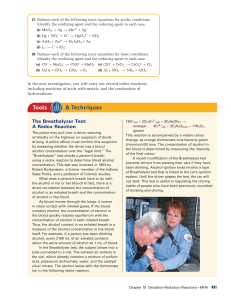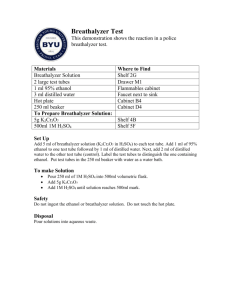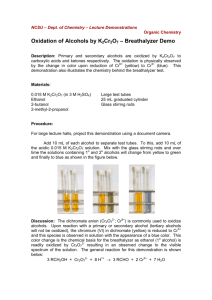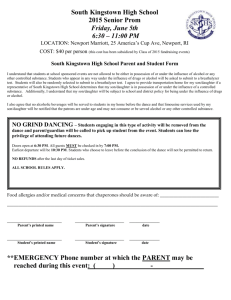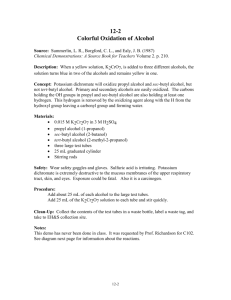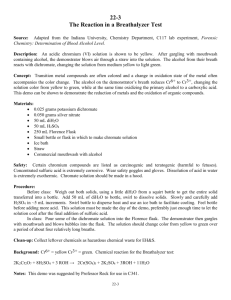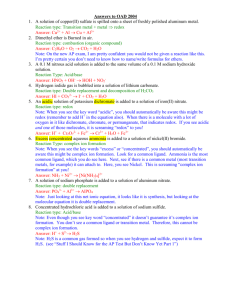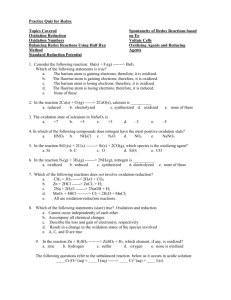Oxidation of the Drunk Driver
advertisement
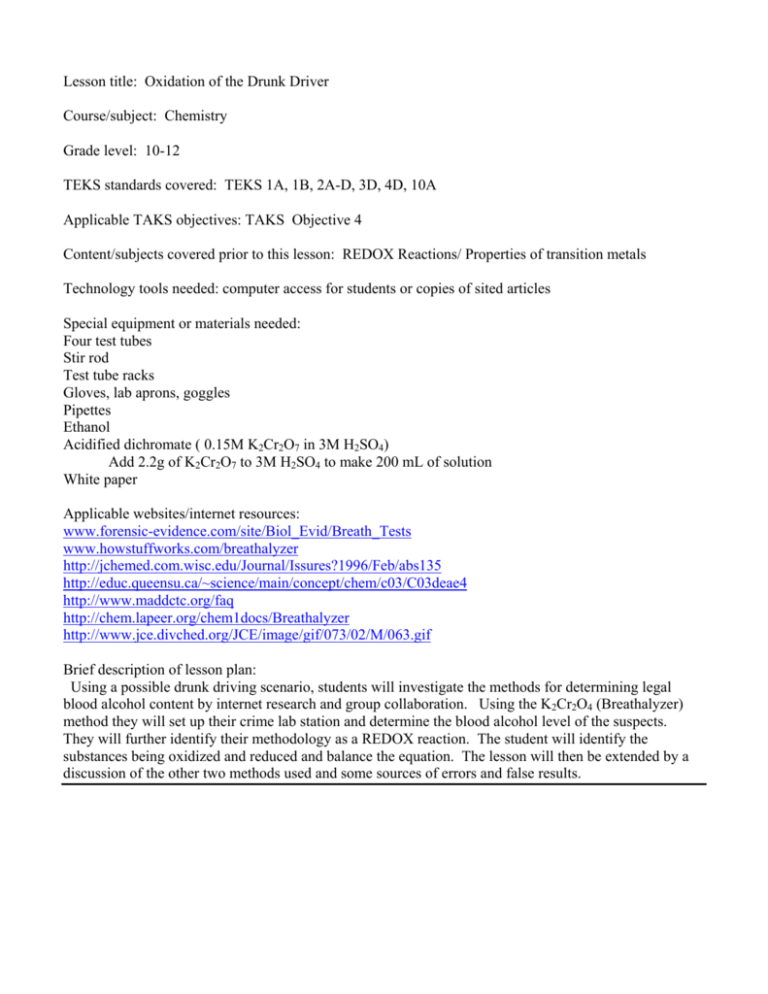
Lesson title: Oxidation of the Drunk Driver Course/subject: Chemistry Grade level: 10-12 TEKS standards covered: TEKS 1A, 1B, 2A-D, 3D, 4D, 10A Applicable TAKS objectives: TAKS Objective 4 Content/subjects covered prior to this lesson: REDOX Reactions/ Properties of transition metals Technology tools needed: computer access for students or copies of sited articles Special equipment or materials needed: Four test tubes Stir rod Test tube racks Gloves, lab aprons, goggles Pipettes Ethanol Acidified dichromate ( 0.15M K2Cr2O7 in 3M H2SO4) Add 2.2g of K2Cr2O7 to 3M H2SO4 to make 200 mL of solution White paper Applicable websites/internet resources: www.forensic-evidence.com/site/Biol_Evid/Breath_Tests www.howstuffworks.com/breathalyzer http://jchemed.com.wisc.edu/Journal/Issures?1996/Feb/abs135 http://educ.queensu.ca/~science/main/concept/chem/c03/C03deae4 http://www.maddctc.org/faq http://chem.lapeer.org/chem1docs/Breathalyzer http://www.jce.divched.org/JCE/image/gif/073/02/M/063.gif Brief description of lesson plan: Using a possible drunk driving scenario, students will investigate the methods for determining legal blood alcohol content by internet research and group collaboration. Using the K2Cr2O4 (Breathalyzer) method they will set up their crime lab station and determine the blood alcohol level of the suspects. They will further identify their methodology as a REDOX reaction. The student will identify the substances being oxidized and reduced and balance the equation. The lesson will then be extended by a discussion of the other two methods used and some sources of errors and false results. I. Engagement: The activities in this section capture the student's attention, stimulate their thinking and help them access prior knowledge. • • • • • Make explicit the mathematical/scientific goal of the lesson. Pose a wonder why question to set the focus and assess prior knowledge and preconceptions. Write sequence of steps and activities students will perform. Specify in what format the questions and activities will be delivered to students. Consider grouping structure, classroom dynamic, grade level, district, state and national standards. This lesson will explore some of the methodologies used to perform forensic alcohol levels. The students will explore a real life application of a REDOX reaction. 1. The following will be projected in the classroom as the students enter at the beginning of the class. It could be enhanced by having a blue or red light flashing and appropriate music playing. Give students about 3-5 minutes. Late one night after attending a party, a car with three suspects is pulled over by a local policeman for driving extremely slow. The policeman smelled alcohol. What happened next? 2. The answers should varyNothing, they were let go. Asked for drives license. Sobriety test Jail. 3. When someone says sobriety test, ask them how the test is done? The students may mention several things. Walking a line heel to toe. Standing on one foot. Breathalyzer. When the breathalyzer is mentioned, ask if anyone knows how the test works? No one may know. Chemical tests (after all this is chemistry class) II. Exploration: In this section students are given time to think, plan, investigate, and organize collected information. • • • Students’ problem solving on their own or in small groups List ways in which teacher might respond to the expected questions and stumbling blocks students may encounter. This may include deeper level questions teacher might raise. List important contextual points that teacher will need to rehearse or remember. The student’s assignment at this point is to research legal blood alcohol levels and tests. They can do this by a computer search. ( a google search of breathalyzer will give them a tremendous amount of information) or if computers are not available, by having printed articles for them to research. This can be done in groups or individually depending on the amount of materials or computers available. Assignment: (20-30 minutes) 1. Research the Breathalyzer test. (4 different sites needed, documentation is needed) 2. List 3 methodologies and explain or write the reactions or tests used. 3. What is currently being used? 4. What is the legal blood alcohol level for our state? 5. What happens to you if you are driving and you are at or above this level? 6. What happens if you are not driving and you have been drinking? 7. How can breathing into a device determine blood alcohol level? III. Explanation: Students are now involved in an analysis of their exploration. Their understanding is clarified and modified through group discussion and reflective activities. • • • Whole-class discussion Predict range of responses and reactions that teacher expects at teach stage in the lesson and explanation. Summarize main mathematical/scientific points. After students have finished their assignment the class is brought back together to discuss the results. (15-20 min.) Methodologies: Breathalyzer- redox reaction with a color change Intoxilyzer- IR spectroscopy Alcosensor III or IV- fuel cell with oxidation of alcohol The last two are more currently used. Legal blood alcohol for Texas is .08 That means that there is .08 g of alcohol in 100ml of blood. If you are drunk while driving in Texas, you go to Jail. If you have been drinking and you are a minor, you will be charged with underage drinking. If you are intoxicated and you are not a minor, you could be charged with public intoxication. The alcohol concentration of the breath is related to the blood alcohol level on 2100:1 ratio. Your lungs are very vascular (have lots of blood vessels), and alcohol is very volatile(evaporates readily at room temp.) The ratio means that 2100 ml of alveolar air will have the same amount of alcohol as 1 ml of blood. Explore and explain further the first method, The Breathalyzer. Ask if this a current methodology? Most should say no. It is used in many personal blood alcohol devices. (Final Call is one of them) Can anyone give the reaction used in this device? K2Cr2O7 + CH3CH2OH + H2SO4 Æ Cr2(SO4)3 + K2SO4 + CH3COOH + H2O (write on overhead, board, or project) Can you identify what is being oxidized and reduced? If students are unable to identify the oxidized and reduced substances review with them the oxidation number rules and how to identify what is oxidized and what is reduced. Cr reduced C(or alcohol) oxidized Where is chromium located in periodic table? Middle, transition element What do we know about transition elements? Metals, multivalent, colors So, chromium will have a different color if it has a different charge? Yes Label the reaction as follows, or have students name the following: K2Cr2O7 + CH3CH2OH + H2SO4 Æ Cr2(SO4)3 + K2SO4 + Potassium alcohol acid chromium potassium Dichromate sulfate sulfate (orange) (green) CH3COOH acetic acid + H2O water In this reaction, the sulfuric acid removes the alcohol from the air and then the alcohol reacts with the alcohol to produce the products. Silver nitrate can be added to this reaction as a catalyst. What is a catalyst? Something that speeds up a reaction. The degree of color change is directly related to the amount of alcohol in the blood. IV. Extension: This section gives students the opportunity to expand and solidify their understanding of the concept and/or apply it to a real world situation. • • • • • Applications of newly learned concepts in other situations or context. Generalization and other representations (e.g. geometric, algebraic, verbal, graphical, or numerical) Thinking Skills Activities o classifying, abstracting, error analysis, etc. Decision-making Exercises Remember our three suspects from the beginning? We will now simulate this type of test to determine whether or not they passed their breathalyzer test. Break the class into groups or do as a demo: (15-20 min) Procedure: 1. Collect the three suspect samples from your instructor, and acidified dichromate solution. 2. Label three test tubes 1, 2, 3, control. 3. Add 10ml of acidified dichromate to each test tube. 4. Add 20 drops of suspect one to tube one. Stir. 5. Add 20 drops of suspect two to tube two. Stir. 6. Add 20 drops of suspect three to tube three. Stir. 7. Wait 60 seconds. 8. Hold the tubes behind a white piece of paper and compare to the control. 9. Write and balance (using half reactions) this reaction. The instructor can make any or all of the suspects “drunk” by adding alcohol to the suspect samples. (This lab could be extended by using a colorimeter and quantifying results.) The class discusses the results of the experiment. Is it possible to get a false positive? False negative? Low lung volume may give false positive. High temperature may give a false positive. Copper penny urban legend. Students may have heard that holding a copper penny in your mouth while blowing into the breathalyzer will cause a false negative. They can either look this up on the computer or you can inform the students that it doesn’t work, depending on time. At this point if there is time you might want to go into the chemistry behind the other two methodologies. V. Evaluation • • Teacher and/or student generated scoring tools or rubrics. Share ideas and experiences through reflection written/orally. Student rubric: Computer research: Participation in class discussion: Participation in lab: Data and results From Lab: Balanced redox reaction: 50 10 10 20 10 Teacher Evaluation: How well were students able to identify the redox reaction? Properties of transition elements? Were safe laboratory practices used? Were students participating in discussion? Lab? Were students able to identify sources of error?
